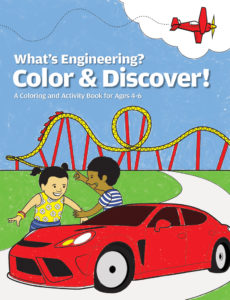Largely at a loss
 Nobody has any very good answers amid the anxiety and trauma of these COVID-19 times. But efforts to help, share, and encourage each other have overflowed in online education communities, to the benefit of educators, students, and families.
Nobody has any very good answers amid the anxiety and trauma of these COVID-19 times. But efforts to help, share, and encourage each other have overflowed in online education communities, to the benefit of educators, students, and families.
Floods of ideas and resources have come from countless individuals and organizations to help the millions of families whose households have suddenly become classrooms. Please, for example, go get a free download of our coloring book, What’s Engineering?
Learning to see
Our goal with the coloring book has always started with the first lesson most people need to learn about engineering: how to know it when they see it. We developed the coloring book to help young kids see the engineering that is always already all around them, in the buildings, cars, toys, and tools that shape their daily lives.
Children’s books are, by definition, great at this work; connecting fun pictures with engaging stories to render make-believe worlds is, from a certain angle, another way of describing engineering itself. Using imagination and ingenuity to conjure up something that does not already exist to please or serve others is both the engineer’s and the writer’s task.
“Design under constraint”
And readers can be seen, too, to hoe in the engineer’s row: identify a problem facing a character, understand how details of the story define the elements of the problem, analyze how a character does or does not solve the problem, and reflect on ways the story touches, even shapes, one’s own experience of the world. This is much what William Wulf, former president of the National Academy of Engineering, had in mind when he would talk about engineering as “design under constraint.” Put more expansively, he meant using technical knowledge of what can be done with available resources and materials to build a solution to a problem people are having, resulting in something generally categorized as technology.
An example
 Okay, all very abstract. To get more particular about how an actual story can serve as the vehicle for delivering a lesson in engineering, let’s consider …Dr. Seuss’s The Cat in the Hat Comes Back.
Okay, all very abstract. To get more particular about how an actual story can serve as the vehicle for delivering a lesson in engineering, let’s consider …Dr. Seuss’s The Cat in the Hat Comes Back.
To refresh, the narrator and his sister Sally – each about late elementary school – have been tasked with shoveling snow while their mother goes to town for the day (hello, social services?!). The Cat in the Hat shows up, settles into the bathtub with a piece of cake, and leaves a ring of pink … something … behind him. He solves successive cleaning problems by removing the pink … something … from various surfaces with a series of apparently inappropriate, but surprisingly effective, household items: mother’s white dress, dad’s $10 shoes, and a carpet runner. The final series of cleaning problems — bed, TV, snowbanks — requires the help of Little Cats A through Z, conveniently stored in the Cat’s hat. Little Cat Z, too tiny to see, deploys cleaning “technology” par excellence, Voom, to affect the final, once-and-for-all clean-up job.
The Engineer in the Hat
 In each instance of cleaning, the Cat in the Hat practices the engineer’s creed — use technical knowledge of available resources to solve a problem someone’s got. Moreover, his persistence in the face of inadequate solutions exemplifies a central dictum of engineering: learn from failure. The Cat optimizes his use of cleaning technologies to meet changing circumstances and arrive at a solution that ultimately meets his kid clients’ needs. In the best tradition of challenging engineering jobs, final success requires a collaborative effort melding team members’ distinctive abilities, all of which add up to an accomplishment beyond what anyone could do on their own.
In each instance of cleaning, the Cat in the Hat practices the engineer’s creed — use technical knowledge of available resources to solve a problem someone’s got. Moreover, his persistence in the face of inadequate solutions exemplifies a central dictum of engineering: learn from failure. The Cat optimizes his use of cleaning technologies to meet changing circumstances and arrive at a solution that ultimately meets his kid clients’ needs. In the best tradition of challenging engineering jobs, final success requires a collaborative effort melding team members’ distinctive abilities, all of which add up to an accomplishment beyond what anyone could do on their own.
Next steps
Extensions to the exercise are easy to formulate and apply to almost any other story: ask kids to identify characters’ problems and then to design and prototype their own engineering solutions with materials at hand. Popsicle sticks, paper clips, pipe cleaners, plain paper, and masking tape, among much else, have been known to yield a wealth of imaginative homemade technologies.
In addition, PBS has built a STEM-focused learning program around the Cat in the Hat. The lessons do not meld story and STEM in the way described above, but the characters and setting will serve to usher kids smoothly into learning experiences about simple machines, force and motion, and properties of materials, among other topics.
 Using stories to teach basic engineering principles and practices can be low-tech, collaborative, and fun. All stories pose conflicts, obstacles, and problems for characters to resolve, and bookshelves can yield a wealth of detail-rich scenarios for parents and kids to identify together the constraints of a nearly endless set of at-home engineering challenges for all ages.
Using stories to teach basic engineering principles and practices can be low-tech, collaborative, and fun. All stories pose conflicts, obstacles, and problems for characters to resolve, and bookshelves can yield a wealth of detail-rich scenarios for parents and kids to identify together the constraints of a nearly endless set of at-home engineering challenges for all ages.
Good wishes to all for making it through to the other side of shelter-in-place orders, peaking infection rates, and the worse hardships plaguing all those directly confronting coronavirus exposure. If any of these ideas spark efforts to make story-based engineering lessons a part of stay-at-home routines, we’ll be glad to count ourselves among Mr. Rogers’s ranks of helpers in times of need.
For breakfast this morning, I chased down a bowl of cereal and fruit with two strong cups of hot, black coffee.
Author: @ericiversen
